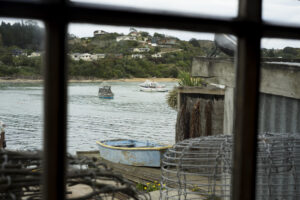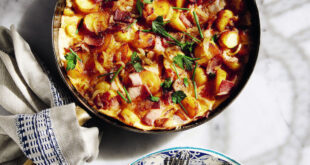Article courtesy of Grow: Wāhine Finding Connection Through Food by Sophie Merkens, RRP $59.99, https://beatnikpublishing.com
 FLEUR SULLIVAN
FLEUR SULLIVAN
MOERAKI, ŌTĀKOU
Moeraki, Otago
Fleur Sullivan is one of New Zealand’s most treasured pioneering restaurateurs. Her eventful career has spanned over 50 years, during which she’s transformed two sleepy small towns into internationally loved foodie destinations. In fact, Fleur is so iconic, you just have to mention her first name in the South Island and everybody knows who you’re talking about. Fleur has been eating wild, foraged, seasonal and local food since childhood and serving it to diners well before it was trendy. She is passionate about natural, wholesome food, and the delicious fare at Fleurs Place is testament to that.
On the drive into Moeraki, I noticed wild banana passionfruit growing, the last of the hawthorn berries in crimson bloom, and fragrant fennel in seed – wild foods that Fleur cooks with. Moeraki translates to ‘a place to sleep by day’, which perfectly encompasses the laid-back feel of the small seaside village. It feels like the end of the world, a great place to heal, forage, gather, and eat.
On the menu at Fleur’s rustic restaurant was fresh Moeraki seafood and mushrooms, tītī (muttonbird), smoked eel, and venison pie, as well as head chef Lyall Minhinnick’s creations of the day. After devouring a bowl of mussels (in a classic white wine and garlic sauce), Fleur and I headed out on a foraging mission. At her secret watercress spot, she stood in the stream collecting while her face lit up with whimsical delight. We wandered down to the beach, where she filled her basket with rimurapa (bull kelp) and deliciously salty horokaka (New Zealand ice plant), to use in the restaurant that evening.
Do you have any early food memories?
My grandma had a coal range when we were kids, and the good things that came out of her oven are my most distinctive food memories. As kids, we were part of that, because we ran and got the blue gum bark and pinecones to get the heat going.
Mum showed us how to find the huhu grubs in the pine trees. My best friend, Noel, and I would gather huhu grubs and put them on the top of his mum’s coal range to cook. We’d use her steel knitting needles to spear them off the top of the coal range and would end up with huhu grub kebabs. It delighted us to see her horrifed that we would end up eating such a thing. They taste like hot crunchy peanut butter.
At Granddad’s farm, where we mostly lived, we got kōura out of the creek, but we called them ‘freshwater lobster’. My grandma scared us to death by telling us there were eels and water rats in the creek. That made it a nerve-wracking thing to be lying on your tummy, your hand in the muddy bank, wondering if you were going to be bitten by a water rat or a freshwater lobster that you were pulling out by its nippers. We would get the kōura, and we had a billy and a wee fire at the creek. We’d pinch the henhouse eggs and put the egg in as well, to boil. That was really good. I would have done this from eight years old until now if I could get the chance.
Also, Dad dug a square in the mud at the bottom of a terrace at the Waitaki River, and there were fingerling eels. It was amazing to get those. We put them on the coal range too.
Was wild food a normal part of your childhood?
Oh yes. We were all fed well. We learned that hunting and gathering was how you got your food and survived. We were in a space in time where we saw the sheep get killed, we saw pigs get hung up. That was your food, and that was your life.
When I was 10, I remember driving Granddad’s car on the river road and Dad would be lying on the running board shooting rabbits. That was normal. So was foraging for all the mushrooms. We were told by the older generation that puffballs and other mushrooms were poisonous – it was just to keep us safe – but we knew they weren’t, because we’d eaten most of them!
What is your favourite mushroom to forage?
The most exciting to find are the birch boletes and porcini. Those are fun, but I grew up with big horse mushrooms in the paddocks; I used to get them by the wheelbarrow-full. Once, at Olivers [her previous restaurant], I made a soup of horse mushrooms and haggis. Oh my goodness, it was amazing. If you get horse mushrooms, then go out and buy yourself some haggis!
 I’m most impressed with your dishes cooked in pōhā (bull kelp bags). Where did you learn that?
I’m most impressed with your dishes cooked in pōhā (bull kelp bags). Where did you learn that?
When we were kids, at the beach, Dad would make us swimming flippers from the bull kelp. You can carve a pretty good cricket ball from the stipe. Things like that were just in my mind.
I don’t remember learning it at all. I’m not quite sure how I decided or if I just thought, ‘I could put my hand in there and put the fish or shellfish in, and that would be like an oven bag.’
You can cook seafood in the pōhā on the beach, on top of corrugated iron, over a re. You can make a tie from plaited harakeke, which you rst soften with a shell. If you’re fairly hungry, you can eat the kelp bag as well.
It’s mid-autumn. What are you foraging for?
Mushrooms and apples. I was looking at the apple trees on the roadside. You want to pick them and eat them while you’re standing there. You don’t strip the tree. You look after the tree, come over during the year and weed around it and fertilise it. Don’t just take take take.
I’ve got the most amazing recipe for autumn windfall apples. You put everything in a big stainless-steel bowl and pour vinegar over it, stir it twice a day for two days, and then you bottle it. That’s the quickest, easiest, most enjoyable thing to do from the wild and windfall apple trees.
I’ve also got a really neat recipe for seawater cottage cheese. You put equal parts clean seawater to full cream milk in a saucepan and bring it to the boil. The milk curdles, which you strain into a delicious salty cheese. That’s really good fun.
There’s fennel growing by the restaurant. I’d love to collect the fennel dust, but it’s illogical for me to do – as someone usually reminds me, I’ve got work to do.
What advice do you have for beginner foragers?
You’ve got to watch for pollution. Don’t forage near roads. Look after and respect the environment that you take from.
Fleur is the sort of person who answers questions with long stories that are mildly related, mostly unprintable, and wholly entertaining for those within earshot. Now in her eighties, she shows no sign of slowing down, still at her restaurant for 12+ hours every day and happily foraging and growing all sorts of goodies. She must have been unstoppable in her youth – pioneering her own way in a male-dominated industry.
I have since made her seawater cheese and can report that it was delightful, just like Fleur. Though her food is undoubtedly natural and delicious, it is her spark that you can’t help but fall for.










Join the Discussion
Type out your comment here:
You must be logged in to post a comment.